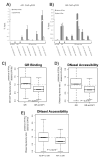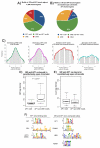Transcription factor AP1 potentiates chromatin accessibility and glucocorticoid receptor binding
- PMID: 21726817
- PMCID: PMC3138120
- DOI: 10.1016/j.molcel.2011.06.016
Transcription factor AP1 potentiates chromatin accessibility and glucocorticoid receptor binding
Abstract
Ligand-dependent transcription by the nuclear receptor glucocorticoid receptor (GR) is mediated by interactions with coregulators. The role of these interactions in determining selective binding of GR to regulatory elements remains unclear. Recent findings indicate that a large fraction of genomic GR binding coincides with chromatin that is accessible prior to hormone treatment, suggesting that receptor binding is dictated by proteins that maintain chromatin in an open state. Combining DNaseI accessibility and chromatin immunoprecipitation with high-throughput sequencing, we identify the activator protein 1 (AP1) as a major partner for productive GR-chromatin interactions. AP1 is critical for GR-regulated transcription and recruitment to co-occupied regulatory elements, illustrating an extensive AP1-GR interaction network. Importantly, the maintenance of baseline chromatin accessibility facilitates GR recruitment and is dependent on AP1 binding. We propose a model in which the basal occupancy of transcription factors acts to prime chromatin and direct inducible transcription factors to select regions in the genome.
Copyright © 2011 Elsevier Inc. All rights reserved.
Figures




References
-
- Adler S, Waterman ML, He X, Rosenfeld MG. Steroid receptor-mediated inhibition of rat prolactin gene expression does not require the receptor DNA-binding domain. Cell. 1988;52:685–695. - PubMed
-
- Carroll JS, Liu XS, Brodsky AS, Li W, Meyer CA, Szary AJ, Eeckhoute J, Shao W, Hestermann EV, Geistlinger TR, et al. Chromosome-wide mapping of estrogen receptor binding reveals long-range regulation requiring the forkhead protein FoxA1. Cell. 2005;122:33–43. - PubMed
-
- De Bosscher K, Vanden Berghe W, Vermeulen L, Plaisance S, Boone E, Haegeman G. Glucocorticoids repress NF-kappaB-driven genes by disturbing the interaction of p65 with the basal transcription machinery, irrespective of coactivator levels in the cell. Proc. Natl. Acad. Sci. USA. 2000;97:3919–3924. - PMC - PubMed
-
- Diamond MI, Miner JN, Yoshinaga SK, Yamamoto KR. Transcription factor interactions: selectors of positive or negative regulation from a single DNA element. Science. 1990;249:1266–1272. - PubMed
Publication types
MeSH terms
Substances
Associated data
- Actions
Grants and funding
LinkOut - more resources
Full Text Sources
Other Literature Sources
Molecular Biology Databases
Research Materials

